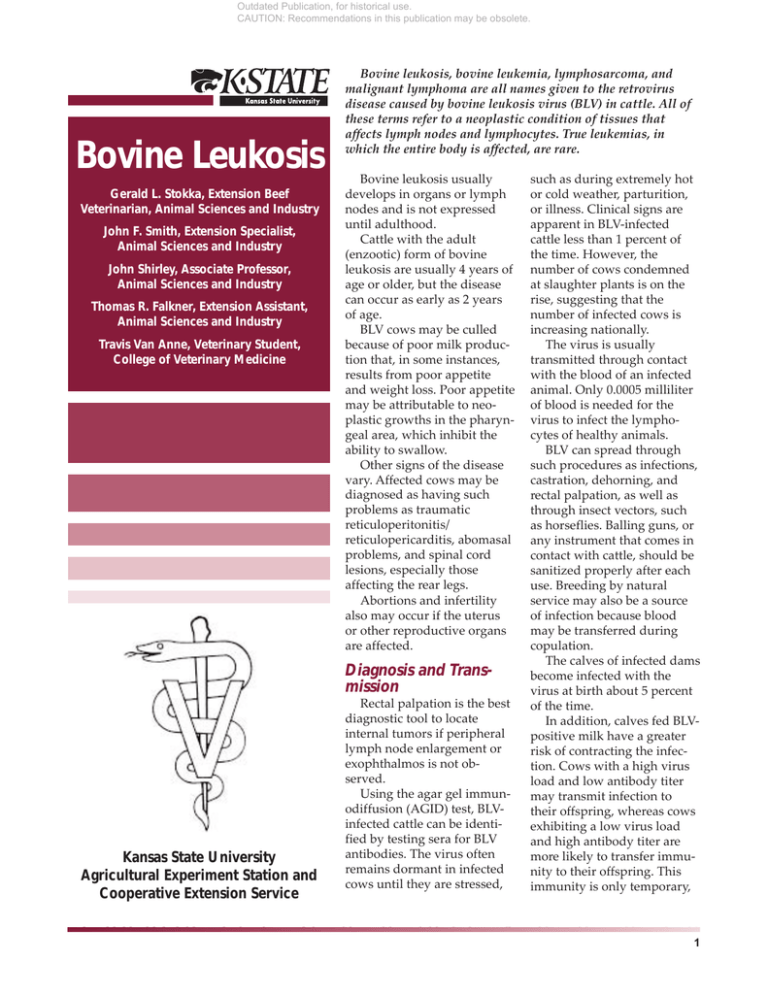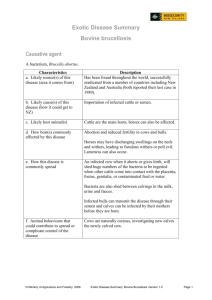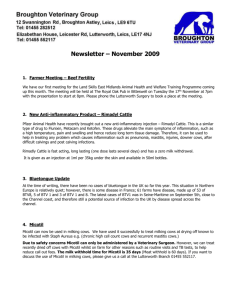
Outdated Publication, for historical use.
CAUTION: Recommendations in this publication may be obsolete.
Bovine Leukosis
Gerald L. Stokka, Extension Beef
Veterinarian, Animal Sciences and Industry
John F. Smith, Extension Specialist,
Animal Sciences and Industry
John Shirley, Associate Professor,
Animal Sciences and Industry
Thomas R. Falkner, Extension Assistant,
Animal Sciences and Industry
Travis Van Anne, Veterinary Student,
College of Veterinary Medicine
Bovine leukosis, bovine leukemia, lymphosarcoma, and
malignant lymphoma are all names given to the retrovirus
disease caused by bovine leukosis virus (BLV) in cattle. All of
these terms refer to a neoplastic condition of tissues that
affects lymph nodes and lymphocytes. True leukemias, in
which the entire body is affected, are rare.
Bovine leukosis usually
develops in organs or lymph
nodes and is not expressed
until adulthood.
Cattle with the adult
(enzootic) form of bovine
leukosis are usually 4 years of
age or older, but the disease
can occur as early as 2 years
of age.
BLV cows may be culled
because of poor milk production that, in some instances,
results from poor appetite
and weight loss. Poor appetite
may be attributable to neoplastic growths in the pharyngeal area, which inhibit the
ability to swallow.
Other signs of the disease
vary. Affected cows may be
diagnosed as having such
problems as traumatic
reticuloperitonitis/
reticulopericarditis, abomasal
problems, and spinal cord
lesions, especially those
affecting the rear legs.
Abortions and infertility
also may occur if the uterus
or other reproductive organs
are affected.
Diagnosis and Transmission
Kansas State University
Agricultural Experiment Station and
Cooperative Extension Service
Rectal palpation is the best
diagnostic tool to locate
internal tumors if peripheral
lymph node enlargement or
exophthalmos is not observed.
Using the agar gel immunodiffusion (AGID) test, BLVinfected cattle can be identified by testing sera for BLV
antibodies. The virus often
remains dormant in infected
cows until they are stressed,
such as during extremely hot
or cold weather, parturition,
or illness. Clinical signs are
apparent in BLV-infected
cattle less than 1 percent of
the time. However, the
number of cows condemned
at slaughter plants is on the
rise, suggesting that the
number of infected cows is
increasing nationally.
The virus is usually
transmitted through contact
with the blood of an infected
animal. Only 0.0005 milliliter
of blood is needed for the
virus to infect the lymphocytes of healthy animals.
BLV can spread through
such procedures as infections,
castration, dehorning, and
rectal palpation, as well as
through insect vectors, such
as horseflies. Balling guns, or
any instrument that comes in
contact with cattle, should be
sanitized properly after each
use. Breeding by natural
service may also be a source
of infection because blood
may be transferred during
copulation.
The calves of infected dams
become infected with the
virus at birth about 5 percent
of the time.
In addition, calves fed BLVpositive milk have a greater
risk of contracting the infection. Cows with a high virus
load and low antibody titer
may transmit infection to
their offspring, whereas cows
exhibiting a low virus load
and high antibody titer are
more likely to transfer immunity to their offspring. This
immunity is only temporary,
1
Outdated Publication, for historical use.
CAUTION: Recommendations in this publication may be obsolete.
however, as it results from
colostral antibodies that last
just a few months.
To date, little evidence
exists that BLV is transmissible to humans. Pasteurization destroys the virus easily,
and it can live only a few
hours at room temperature
outside of living cells.
Families that consumed
raw milk containing the virus
were studied and found to be
free of BLV infection.
In addition, veterinarians
and others who work closely
with BLV-positive blood on a
daily basis have not been
infected.
Economic Losses
Breeders of purebreds
suffer the biggest economic
losses if their cattle are found
to be BLV-positive. Many
countries and U.S. companies
will not accept animals or
animal products infected with
BLV. Heifers or semen may be
rejected, resulting in a large
monetary loss to the breeder.
Some countries also require
embryo-producing dams to
be seronegative. The economic impact to commercial
dairy producers includes
treatment and diagnostic
costs, reduced performance,
on-farm death losses, condemned carcasses, and cost of
replacements.
Prevalence in U.S.
Dairies
The number of cows in the
United States condemned at
slaughter because of lymph
node tumors
(lymphoasrcomas) tripled
between 1975 and 1990 and is
now nine times that of what
Denmark was during the
1950s (before leukosis control
and eradication programs had
begun).
2
It has been suggested that
less than 2 percent of infected
cows will develop lymphosarcoma in a typical dairy
operation each year.
The total number of U.S.
animals infected with BLV
has not been determined;
however, in a study of the
upper midwest states during
the 1970s, approximately 20
percent of cows were estimated to be infected.
In 1984, some states,
including Wisconsin (22.2
percent), Florida (47.7 percent, and Michigan (30
percent) reported the prevalence of BLV-infected dairy
cattle. Beef cows had lower
infection rates, ranging from
0.12 percent to 6.7 percent.
More recent information
indicates that 89 percent of
U.S. dairy operations contain
BLV-positive cattle.
The increasing number of
condemned carcasses suggests that the current management of dairy cows is not
preventing additional BLV
infections. Although BLV is
not easily spread from animal
to animal, increasing animal
density per pen and exposure
to blood increase the risk of
transmission.
Calf management practices, such as gouge dehorning, ear tagging, and branding, can contaminate feed
areas and other facilities with
blood.
Multiple use of the same
needle during routine vaccinations, use of unsterilized
needles, and not changing
gloves during insemination or
pregnancy testing can also
increase the number of BLVpositive animals.
Establishing an Elimination Program
Because no BLV vaccine is
available, establishing new
management and veterinary
practices is the key to controlling the disease (see Recommendations for Reducing BLV
Transmission). The first step
is blood testing, which allows
BLV-positive animals to be
identified and grouped
separately.
The serologic test of
animals younger than 6
months of age may show
false-positive results because
of the presence of colostral
antibodies. Pregnant animals
should be serotested at least 6
weeks before parturition to
prevent false-negatives,
which result from immunoglobulins shifting to colostrum.
Simply separating infected
animals will reduce incidence
when older BLV-positive
cows are replaced by BLVnegative heifers.
Complete eradication
programs should be implemented by dairies that sell
heifers, embryos, or semen so
they can achieve BLV-free
status for their herds. Only
one state, New York, has
certification programs to
identify BLV-free dairy herds.
Proposals for control
include:
• Identifying sick animals
through regular blood
testing.
• Establishing practices and
procedures to prevent the
transfer of blood or other
fluids from BLV-positive to
BLV-negative animals.
• Isolating infected from
noninfected animals.
• Increasing culling rates
may also help to rid the
herd of BLV-positive cows
more quickly and to reduce
exposure of healthy
animals.
Outdated Publication, for historical use.
CAUTION: Recommendations in this publication may be obsolete.
Recommendations
for reducing BLV
transmission
• Use only single-use disposable needles and palpation
sleeves and then discard.
• Thoroughly clean all
surgical instruments that
come into contact with
blood, such as those for
dehorning, castration, extra
teat removal, tagging, and
tattooing.
• Disinfect instruments
between uses.
• Reduce numbers of biting
insects
• Test all cattle entering the
herd for BLV, and isolate
them for 30 to 60 days. Test
again at the end of the
isolation period.
• Implement annual testing
for all animals. A 3- to 4month testing interval is
preferred but may be
impractical.
• Use BLV-negative bulls or
semen for all breedings.
• Do not use colostrum or
milk from BLV-positive
cows. Feed calves milk
replacer or pasteurized
milk when BLV-free milk is
not available.
• Store intravenous tubing
and needles in a disinfectant solution, such as
chlorhexidine.
• Cold sterilize calf delivery
equipment between uses.
• Do not use BLV-positive
cows as recipients for
embryo transfer. If a highly
valuable donor is tested
positive, implant embryos
in BLV-negative cows and
test the offspring of the
donor to be sure they are
BLV-free.
• Remove extra teats, insert
ear tags, and dehorn while
calves are housed individually.
• Use bloodless dehorning
methods, such as electric,
hot iron, or caustic paste.
• Clean feed and water
containers regularly to
reduce blood contamination.
• Perform all veterinary
procedures on BLV-positive
cows last.
• Milk all BLV-positive cows
last.
Miller J: Personal communication, USDA, National
Animal Disease Center, Ames,
IA, 1996.
Whittier D: Programs can
rid herds of bovine leukosis.
Hoard's Dairyman 138(8):405,
1990.
Johnson R, Kaneene JB:
Bovine leukosis is caused by a
virus. Hoard's Dairyman
129(11):716-717, 1984.
Smith B: Large animal
internal medicine, ed 2. St
Louis, Mosby-year book,
1996, p 1238.
Howard T: Is bovine leukosis
out of control? Hoard's Dairyman 137(14)571, 1992.
Samagh BS, Kellar JA:
Seroepidemiological survey of
bovine leukaemia virus infection
in Canadian cattle, in Straub
OC (ed): Current Topics in
Veterinary Medicine and
Animal Science, Vol.
15._____1980, pp 397-411.
High prevalence of BLV in
U.S. dairy herds. USDA,
APHIS, VS, NAHMS
228:197,1997.
Johnson R, Kaneene JB:
Bovine leukemia virus. Part IV.
Economic impact and control
measures. Compend Contin
Educ Pract Vet 13(11):17271737, 1991.
McGinnis CW: Bovine
leukosis control. Dairy briefs
(Cooperative Extension
Service, University of New
Hampshire) 32(1):8, 1987.
3
Outdated Publication, for historical use.
CAUTION: Recommendations in this publication may be obsolete.
Brand names appearing in this publication are for identification purposes only. No endorsement is intended,
nor is criticism implied of others not mentioned.
Publications from Kansas State University are available on the World Wide Web at: http://www.oznet.ksu.edu
Contents of this publication may be freely reproduced for educational purposes. All other rights reserved. In each case, credit
Gerald L. Stokka, Robin Falkner, Patrick Bierman, Bovine Leukosis, Kansas State University, November 1998.
Kansas State University Agricultural Experiment Station and Cooperative Extension Service
EP-51
November 1998
It is the policy of Kansas State University Agricultural Experiment Station and Cooperative Extension Service that all persons shall have equal opportunity and access to its educational programs, services, activities, and materials without regard to race, color, religion, national origin, sex, age or disability.
Kansas State University is an equal opportunity organization. Issued in furtherance of Cooperative Extension Work, Acts of May 8 and June 30, 1914, as
amended. Kansas State University, County Extension Councils, Extension Districts, and United States Department of Agriculture Cooperating, Marc A.
Johnson, Director.
4







